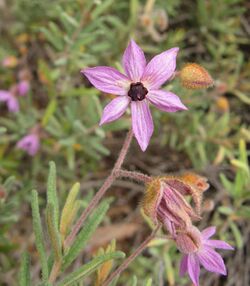Biology:Lysiosepalum
| Lysiosepalum | |
|---|---|

| |
| Lysiosepalum involucratum | |
| Scientific classification | |
| Kingdom: | Plantae |
| Clade: | Tracheophytes |
| Clade: | Angiosperms |
| Clade: | Eudicots |
| Clade: | Rosids |
| Order: | Malvales |
| Family: | Malvaceae |
| Subfamily: | Byttnerioideae |
| Tribe: | Lasiopetaleae |
| Genus: | Lysiosepalum F.Muell.[1] |
| Species | |
|
See text | |
Lysiosepalum is a genus of 5 species of flowering plants in the genus of plants in the family Malvaceae, all endemic to the south-west of Western Australia.
Description
All species of Lysiosepalum are shrubs up to 1.5 m (4 ft 11 in) high. The leaves are mostly linear to egg-shaped with 2 leaf-like stipules at the base of the petiole. There are petal-like sepals alternating between broad to narrow, and tiny, scale-like petals. Three egg-shaped or lance-shaped bracteoles are below the sepals, bracts at the base of the pedicels, the stamens are joined at the base and there are tiny staminodes.[2][3][4]
Taxonomy
The genus Lysiosepalum was first formally described in 1858 by Ferdinand von Mueller in his Fragmenta Phytographiae Australiae, and the first species he described (the type species) was Lysiosepalum barryanum.[5][6] The genus name means a "setting-free sepal", referring to the sepals, which are almost free or separated.[2][7]
Species list
The following is a list of names of Lysiosepalum species accepted by the Australian Plant Census as at April 2022:[8]
- Lysiosepalum abollatum C.F.Wilkins - woolly lysiosepalum
- Lysiosepalum aromaticum C.F.Wilkins
- Lysiosepalum hexandrum (S.Moore) S.Moore
- Lysiosepalum involucratum (Turcz.) Druce
- Lysiosepalum rugosum Benth. - wrinkled-leaf lysiosepalum
Distribution and habitat
Species of Lysiosepalum occur in open woodland or shrubland between Yuna and Ravensthorpe in the south-west of Western Australia.[3][4]
References
- ↑ "Lysiosepalum". Australian Plant Census. https://biodiversity.org.au/nsl/services/apc-format/display/81950.
- ↑ 2.0 2.1 Blake, Trevor L. (2021). Lantern Bushes of Australia; Thomasias & Allied Genera. Australia: A.P.S. Keiler Plains Inc.. p. 376. ISBN 9780646839301.
- ↑ 3.0 3.1 Wilkins, Carolyn F. (2001). "A taxonomic revision of the Western Australian genus Lysiosepalum (Malvaceae: Lasiopetaleae).". Nuytsia 13 (3): 579–580. https://www.biodiversitylibrary.org/item/225810#page/175/mode/1up. Retrieved 16 November 2023.
- ↑ 4.0 4.1 "Lysiosepalum". FloraBase. Western Australian Government Department of Parks and Wildlife. https://florabase.dpaw.wa.gov.au/browse/profile/21782.
- ↑ "Lysiosepalum". APNI. https://id.biodiversity.org.au/instance/apni/498791. Retrieved 30 December 2020.
- ↑ von Mueller, Ferdinand (1859). Fragmenta Phytographiae Australiae. 1. Melbourne: Victorian Government Printer. pp. 142–143. https://www.biodiversitylibrary.org/item/7218#page/149/mode/1up. Retrieved 16 November 2023.
- ↑ Sharr, Francis Aubi; George, Alex (2019). Western Australian Plant Names and Their Meanings (3rd ed.). Kardinya, WA: Four Gables Press. p. 331. ISBN 9780958034180.
- ↑ "Lysiosepalum". Australian Plant Census. https://biodiversity.org.au/nsl/services/search/taxonomy?product=APC&tree.id=51209179&name=Lysiosepalum&inc._scientific=&inc.scientific=on&inc._cultivar=&max=100&display=apc&search=true.
Wikidata ☰ Q2084395 entry
 |

